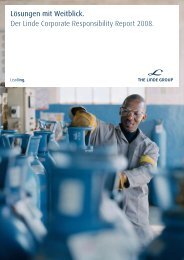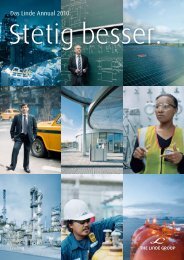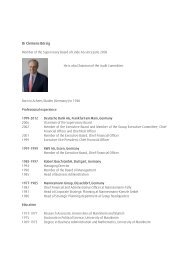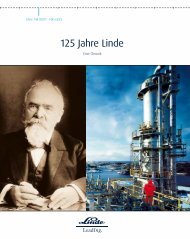The complete history of the development of The - The Linde Group
The complete history of the development of The - The Linde Group
The complete history of the development of The - The Linde Group
You also want an ePaper? Increase the reach of your titles
YUMPU automatically turns print PDFs into web optimized ePapers that Google loves.
N o 0006<br />
Improved gland design.<br />
First customers and partners: brewers<br />
Fermentation cellar <strong>of</strong> a brewery with natural convection cooling.<br />
10<br />
1882<br />
First electric streetlights in Berlin.<br />
In 1840, many continental European<br />
breweries switched to bottomfermented<br />
lager production (in contrast to <strong>the</strong><br />
“English” top-fermented brown beers or<br />
ales) because <strong>the</strong> beer remained fresh<br />
longer and customers preferred <strong>the</strong><br />
taste. <strong>The</strong> ice machine described by von<br />
<strong>Linde</strong> seemed ideal for achieving <strong>the</strong><br />
required lower temperatures and to<br />
ensure precise cooling control. So it is<br />
no wonder that some major brewers<br />
showed great interest in this invention.<br />
Gabriel Sedlmayr <strong>of</strong> <strong>the</strong> Munich<br />
Spaten Brewerey was willing to let von<br />
<strong>Linde</strong> experiment with an early refrigeration<br />
machine in his brewery in <strong>the</strong> early<br />
1870s. <strong>The</strong> first unit functioned passably<br />
well, but was too large and had numerous<br />
flaws. <strong>The</strong> drawings submitted for<br />
<strong>the</strong> patent showed that Sedlmayr himself<br />
had a hand in <strong>the</strong> second version,<br />
which was significantly smaller in size<br />
and worked well. This unit was sold to<br />
<strong>the</strong> Trieste Dreher Brewery for air cooling.<br />
With Sedlmayr as an intermediary, <strong>the</strong><br />
Rotterdam Heineken Brewery under its<br />
director Feldmann ordered an ice machine<br />
in 1877 for ice production. In his collaboration<br />
with <strong>the</strong> Heineken Brewery, <strong>Linde</strong><br />
developed “natural convection cooling”<br />
with a system <strong>of</strong> cooling pipes under <strong>the</strong><br />
ceiling <strong>of</strong> <strong>the</strong> cellar. Feldmann in turn put<br />
von <strong>Linde</strong> in contact with J. C. Jacobsen,<br />
head <strong>of</strong> <strong>the</strong> Carlsberg Brewery in Copenhagen,<br />
who ordered a large refrigeration<br />
unit in 1878.<br />
Karl Lang, technical adviser and supervisory<br />
board member <strong>of</strong> several Rhineland<br />
breweries, also played a significant<br />
role during <strong>the</strong> founding period <strong>of</strong> <strong>the</strong><br />
“Gesellschaft für <strong>Linde</strong>’s Eismaschinen.”<br />
He introduced <strong>Linde</strong> to brewery director<br />
Gustav Jung, who not only ordered a<br />
refrigeration unit but also became, with<br />
Lang and banker Moritz von Hirsch, a<br />
shareholder and Supervisory Board<br />
member <strong>of</strong> <strong>the</strong> <strong>Linde</strong> Company.<br />
<strong>The</strong> connection between <strong>the</strong> <strong>Linde</strong><br />
Company and brewery directors was<br />
maintained to some extent over several<br />
generations. After <strong>the</strong> death <strong>of</strong> Karl Lang<br />
in 1894 his position as chairman <strong>of</strong> <strong>the</strong><br />
Supervisory Board was taken over by<br />
Gustav Jung, followed by his son Adolf<br />
Jung in 1886. Carl Sedlmayr took over<br />
for his fa<strong>the</strong>r Gabriel on <strong>the</strong> Supervisory<br />
Board and in 1915, <strong>the</strong> third generation<br />
<strong>of</strong> this family followed with Anton Sedlmayr.<br />
<strong>The</strong> Jung and Sedlmayr families<br />
held <strong>the</strong>ir Supervisory Board seats until<br />
after <strong>the</strong> Second World War.<br />
N o 0010 Circulation <strong>of</strong> cold saltwater<br />
brine in cooling tubes for direct cooling <strong>of</strong> fermentation<br />
and storage cellars, known as natural convection cooling.<br />
Even before <strong>the</strong> founding <strong>of</strong> <strong>the</strong> “Gesellschaft für <strong>Linde</strong>’s Eismaschinen<br />
Aktiengesellschaft,” von <strong>Linde</strong> had already delivered<br />
20 refrigeration systems in Europe. In 1878 already, <strong>the</strong> pr<strong>of</strong>essor<br />
decided to bundle his activities into a company and concentrate<br />
on refining and marketing his refrigeration machines. In<br />
order to do so, he had to leave his stable job in <strong>the</strong> civil service.<br />
His negotiations with Karl Lang, <strong>the</strong> technical adviser and<br />
supervisory board member <strong>of</strong> many Rhineland breweries, were<br />
a decisive factor in this decision. In 1878 he advised Carl von<br />
<strong>Linde</strong> to give up teaching and take up a position as head <strong>of</strong> his<br />
own company.<br />
Going into business<br />
After thinking it over for some time, von <strong>Linde</strong> decided to give<br />
up his secure civil service position as a university instructor and<br />
jump into <strong>the</strong> risky world <strong>of</strong> business. With Lang and banker<br />
Moritz von Hirsch, who wanted to help finance <strong>the</strong> young company,<br />
von <strong>Linde</strong> came to an agreement on pension and disability<br />
pay, in exchange for which he granted <strong>the</strong>m patent rights.<br />
In addition to Lang and von Hirsch, <strong>Linde</strong>’s previous partners<br />
Gabriel and Johann Sedlmayr, locomotive manufacturer Georg<br />
Krauss and Heinrich von Buz, Director <strong>of</strong> Maschinenfabrik Augsburg<br />
subscribed for shares in <strong>the</strong> recently-founded “Gesellschaft für<br />
<strong>Linde</strong>’s Eismaschinen.” Finally in May 1879, Gustav Jung, owner<br />
<strong>of</strong> <strong>the</strong> Aktienbrauerei in Mainz, also became a shareholder in<br />
<strong>the</strong> company, which made Wiesbaden its main location.<br />
At first <strong>the</strong> young company’s purse strings were tight. Against<br />
von <strong>Linde</strong>’s calls to fund <strong>the</strong> company with 400,000 marks starting<br />
capital, Hirsch and Lang insisted on investing only 200,000<br />
marks – and not even in cash, but by contributing <strong>the</strong> patents.<br />
<strong>The</strong> original supervisory board at <strong>the</strong> company’s founding on<br />
June 21, 1879 included Lang (chairman), Sedlmayr, Krauss, Buz<br />
and Jung.



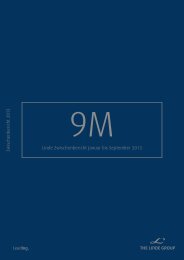
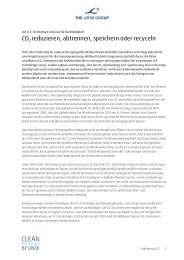

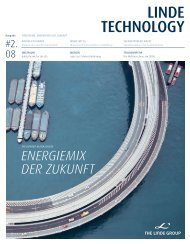
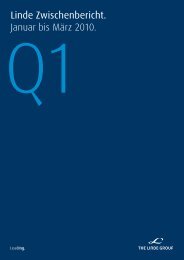
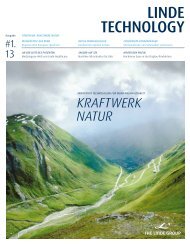

![[41] Anteilsbesitzliste des Linde Konzerns und ... - The Linde Group](https://img.yumpu.com/8356102/1/184x260/41-anteilsbesitzliste-des-linde-konzerns-und-the-linde-group.jpg?quality=85)
![[41] Anteilsbesitzliste des Linde Konzerns und ... - The Linde Group](https://img.yumpu.com/8356076/1/184x260/41-anteilsbesitzliste-des-linde-konzerns-und-the-linde-group.jpg?quality=85)
